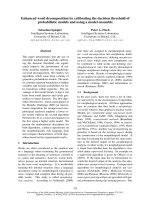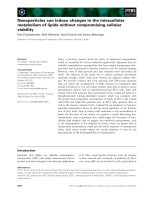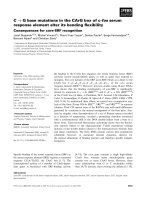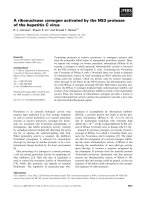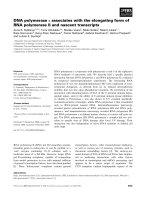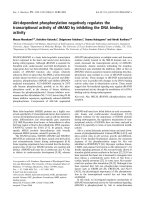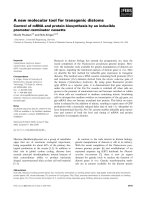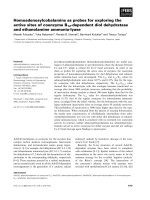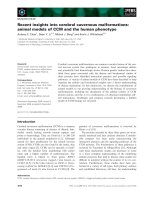Báo cáo khoa học: "Daily enteral feeding practice on the ICU: attainment of goals and interfering factors" ppsx
Bạn đang xem bản rút gọn của tài liệu. Xem và tải ngay bản đầy đủ của tài liệu tại đây (142.2 KB, 8 trang )
Open Access
Available online />R218
Vol 9 No 3
Research
Daily enteral feeding practice on the ICU: attainment of goals and
interfering factors
JM Binnekade
1
, R Tepaske
2
, P Bruynzeel
3
, EMH Mathus-Vliegen
4
and RJ de Haan
5
1
Research Nurse, Department of Intensive Care, Academic Medical Center, University of Amsterdam, Amsterdam, The Netherlands
2
Intensivist, Department of Intensive Care, Academic Medical Center, University of Amsterdam, Amsterdam, The Netherlands
3
Dietician, Department of Dietetics, Academic Medical Center, University of Amsterdam, Amsterdam, The Netherlands
4
Gastroenterologist, Department of Gastroenterology, Academic Medical Center, University of Amsterdam, Amsterdam, The Netherlands
5
Clinical Epidemiologist, Department of Clinical Epidemiology and Biostatistics, Academic Medical Center, University of Amsterdam, Amsterdam, The
Netherlands
Corresponding author: JM Binnekade,
Received: 8 Dec 2004 Revisions requested: 19 Jan 2005 Revisions received: 31 Jan 2005 Accepted: 21 Feb 2005 Published: 22 Mar 2005
Critical Care 2005, 9:R218-R225 (DOI 10.1186/cc3504)
This article is online at: />© 2005 Binnekade et al.; licensee BioMed Central Ltd.
This is an Open Access article distributed under the terms of the Creative Commons Attribution License ( />2.0), which permits unrestricted use, distribution, and reproduction in any medium, provided the original work is properly cited.
Abstract
Background The purpose of this study was to evaluate the daily
feeding practice of enterally fed patients in an intensive care unit
(ICU) and to study the impact of preset factors in reaching
predefined optimal nutritional goals.
Methods The feeding practice of all ICU patients receiving
enteral nutrition for at least 48 hours was recorded during a 1-
year period. Actual intake was expressed as the percentage of
the prescribed volume of formula (a success is defined as 90%
or more). Prescribed volume (optimal intake) was guided by
protocol but adjusted to individual patient conditions by the
intensivist. The potential barriers to the success of feeding were
assessed by multivariate analysis.
Results Four-hundred-and-three eligible patients had a total of
3,526 records of feeding days. The desired intake was
successful in 52% (1,842 of 3,526) of feeding days. The
percentage of successful feeding days increased from 39%
(124 of 316) on day 1 to 51% (112 of 218) on day 5. Average
ideal protein intake was 54% (95% confidence interval (CI) 52
to 55), energy intake was 66% (95% CI 65 to 68) and volume
75% (95% CI 74 to 76). Factors impeding successful nutrition
were the use of the feeding tube to deliver contrast, the need for
prokinetic drugs, a high Therapeutic Intervention Score System
category and elective admissions.
Conclusion The records revealed an unsatisfactory feeding
process. A better use of relative successful volume intake,
namely increasing the energy and protein density, could
enhance the nutritional yield. Factors such as an improper use
of tubes and feeding intolerance were related to failure.
Meticulous recording of intake and interfering factors helps to
uncover inadequacies in ICU feeding practice.
Introduction
Protein energy malnutrition is a major problem in severely ill
hypercatabolic patients in the intensive care unit (ICU) [1].
Early initiation of enteral nutrition has proved to be beneficial,
with significant positive effects on septic complications, and
has been shown to improve the outcome when compared with
parenteral nutrition. Enteral nutrition guarantees the preserva-
tion of gut mass and prevents increased gut permeability to
bacteria and toxins [2-5]. In addition, the gut-associated lym-
phoid tissue is better maintained [4].
Over the years, enteral nutrition has improved with regard to
techniques, materials and composition, and has gained popu-
larity because of its lower cost and lower rate of complications
compared with parenteral nutrition. This is also reflected in our
intensive care by an increased use of enteral nutrition from
16.7% of total patient days in 1992 to 53.8% in 2001, and a
slightly decreased use of parenteral nutrition, from 19% of
total patient days in 1992 to 14% in 2001.
Although this large increase in enteral feeding days has to be
considered a step forward, these figures do not show the
APACHE = Acute Physiology and Chronic Health Evaluation; CI = confidence interval; CT = computed tomography; ICU = intensive care unit; NCJ
= needle catheter jejunostomy; TISS = Therapeutic Intervention Score System.
Critical Care Vol 9 No 3 Binnekade et al.
R219
actual intake of energy and nutrients per patient; that is, the
adequacy of feeding. Despite the attention given to the prac-
tice of enteral nutrition in daily rounds by intensivists and ICU
nurses, we were not adequately and accurately informed as to
the adequacy of our feeding practice [6]. Confronted with a
growing number of enterally fed patients we decided to
develop a daily record, aimed at obtaining a continuous and
long-term overall insight into the volume, energy content and
amount of proteins administered to and actually received by
the patient. The objective of this study was to evaluate the suc-
cess of enteral nutrition in our ICU and to report the influence
of factors presumed to interfere and, being part of the record,
to achieve an optimal nutritional intake.
Materials and methods
Setting
The study was conducted in a 30-bed intensive care unit with
access to patients of all specialties at the Academic Medical
Center in Amsterdam, a tertiary care university teaching hospi-
tal with 1,000 beds.
Feeding process
Standard feeding practice involved the continuous administra-
tion of enteral feeding solutions over 24 hours. Although a
standard feeding protocol was in use (see Additional file 1) the
flow rate was often adjusted according to the understanding
of the intensivist.
Patients started feeding at 500 ml per day with a build-up of
500 ml per 24 hours until the individually determined intake in
terms of volume, proteins and calories was reached. Given an
uneventful course a patient would achieve an intake of 2,000
ml within 5 days. However, to compensate for interruptions of
feeding, the intake was targeted at a 20% higher volume. The
optimal feeding target of 2,000 kcal per 24 hours therefore
became 2,400 kcal per 24 hours after adjustment.
Data collection
Patients admitted to the ICU and receiving enteral nutrition for
at least 48 hours were eligible. The study duration for each
patient was limited to 30 days. In this retrospective database
study we extracted the daily records of enterally fed patients
over a period of 1 year. Records containing a single oral-nutri-
tion or total parenteral-nutrition day, or records that lacked a
prescription of desired intake, were excluded from the
analysis.
Feeding factors assumed to interfere with enteral nutrition and
noted in the record were as follows: first, the type of feeding
tube (gastric tube, duodenal tube, percutaneous endoscopic
gastrostomy, or needle catheter jejunostomy (NCJ)); second,
the type of formula with different energy content (100 to 204
kcal/100 ml) and protein content (4 to 7 g/100 ml) and normal
or predigested semi-elemental form; third, gastric retention;
fourth, therapeutic interventions (mechanical ventilation,
endotracheal tube in situ, extubation/intubation, spontaneous
respiration, tracheostomy, continuous veno-venous haemofil-
tration, prone position, and preparation for computed tomog-
raphy scan); and fifth, medication (lactulose, cisapride,
midazolam–morphine, morphine, propofol, vasopressors, ino-
tropics and pantoprazol).
The feeding record was coupled to other databases to extract
data on gender, age, length of stay and referral specialty in the
ICU, the Acute Physiology and Chronic Health Evaluation
score (APACHE II) and the therapy intensity with the Thera-
peutic Intervention Score System (TISS). The TISS scores
were calculated for each patient and subdivided into four cat-
egories, classifying the patient's need for ICU care: in category
1 the score was less than 10 points (no need for ICU care); 2,
a score of 10 or more to less than 20 points (physiologically
stable condition with prophylactic overnight observation); 3 a
score of more than 20 to less than 40 points (physiologically
stable but requiring intensive nursing and monitoring); and 4,
a score of more than 40 points (unstable condition requiring
intensive physician and nursing care) [7]. The APACHE II [8]
was scored upon admission (within 24 hours); APACHE II
scores could range from 0 to 71, with higher scores indicating
a more severe illness.
Reliability of the record
As the record had to be filled in by several staff members, its
reliability had to be tested. An interobserver study was per-
formed between two regular keepers of the record (a dietician
and an intensivist). Nursing charts of 42 feeding days for 14
patients (3 days per patient) were evaluated by three different
observers and the data were entered into the record.
Analyses
Descriptive statistics were used to characterize patients. Suc-
cessful intake was defined as a patient's receiving 90% or
more of the prescribed amount of feeding. The difference
between the prescribed amount and the tube feeding actually
administered was expressed as a percentage and its associ-
ated 95% confidence interval (95% CI). The percentages
(95% CIs) of realized energy and protein needs were based
on a ideal 30 kcal per kg of body weight [9] and 1.5 g of pro-
tein per kg of body weight [10,11], respectively. The volume,
energy and protein intake were stratified by type of formula
and arranged by type of enteral route (total of 28 strata).
Patients with zero intake but having a feeding prescription
remained in the analysis.
Univariate analysis was performed to assess determinants of
successful intake with regard to patients and feeding factors.
Before inclusion into the model the independence of these
explanatory variables had to be determined. The most common
value of the categories (referral specialty, type of feeding tube
and type of formula) were used as reference category (odds
ratio of 1). Each category of the predictor variable was then
Available online />R220
compared with the reference category for categorical
variables.
Significant variables in the univariate analysis (P ≤ 0.10) from
patients and feeding factors were forced into the multivariate
logistic regression model (enter method).
The results of the univariate analysis were also compared for
the data set of the complete feeding period and a data set of
the first three feeding days. Significant differences might show
influences of a skewed duration of feeding.
Statistical uncertainty was expressed as 95% CI. Data were
analyzed in SPSS version 11.5.
Results
In 2001, 1,479 patients were admitted to the ICU. After the
removal of elective admissions with a limited stay of less than
48 hours, the crude data set contained 5,859 feeding days.
Because the analysis was limited to 30 days of ICU stay,
5,017 days remained. The removal of feeding days with one
single day of oral or total parenteral nutrition and the removal
of patients who did not receive a prescription for enteral feed-
ing resulted in 3,526 days to be analyzed in 403 patients.
There was a significant difference between neurosurgery and
the other specialties for length of ICU stay. APACHE II scores
did not differ between medical and neurosurgery patients.
Medical patients had the highest APACHE II score, signifi-
cantly higher than those of surgical and cardiac surgical
patients (Table 1).
Reliability of the record
The test of reliability showed an intra-class correlation (two-
way random model) of 0.98 (95% CI 0.96 to 0.99).
Success of enteral nutrition
During the build-up phase of feeding, the number of success-
ful feeding days increased from 39% (124 of 316) on day 1 to
51% (112 of 218) on day 5. At discharge from the ICU only
4% (14 of 371) of patients received 100 ml/hour or more
enteral nutrition. Twenty-five percent (93 of 371) of patients
left the ICU with an intake of 80 ml/hour, whereas 71% (264
of 371) of patients received 60 ml/hour or less. Thirty-three
patients stayed for longer than 30 days in the ICU; food intake
on discharge was therefore not analyzed.
The percentage of successful intake and ideal energy and
ideal protein calculated for each type of formula and for each
type of enteral route showed an overall picture of deficiency.
Of the 28 strata, 21 were analyzable (Table 2). Ten strata
showed the highest percentage for volume, another ten for
energy and only one for protein. In eight strata protein turned
out to be less important than volume, whereas in seven strata
protein was less important than the percentage of energy
(Table 2).
Table 1
Characteristics of ICU patients recorded in the 1-year enteral feeding practice (n = 404)
Characteristic Value
Male patients, % 63 (256 of 404)
Age, years (mean ± SD) 60 ± 17
Length of stay, days (median and IQ)
Overall 8 (5/16)
Medical (n = 112) 9 (6/18)
Surgical (n = 117) 8 (5/16)
Cardiac surgery (n = 122) 7 (5/14)
Neurosurgery (n = 53) 10 (6/16)
APACHE II score (mean ± SD)
Overall 18 ±7
Medical 23 ± 7
Surgical 17 ± 6
Cardiac surgery 16 ± 5
Neuro(surgery) 20 ± 6
IQ, interquartile range.
Critical Care Vol 9 No 3 Binnekade et al.
R221
Factors interfering with successful administration of
enteral feed
Tube location
The percentage of days with successful feeding was smallest
for gastric tubes and greatest for duodenal/jejunal tubes
(Table 3). The NCJ had significantly more successful feeding
days than the duodenal tube; the difference was 19% (95%
CI 27 to 10) (Table 3).
Gastric retention
Patients fed by duodenal tube had the highest gastric reten-
tion, with a mean of 558 (95% CI 523 to 593) ml/24 hours.
The mean gastric retention among patients with a gastric tube
was 159 (148 to 170) ml/24 hours. Of these, a mean of 121
(110 to 132) ml gastric retention over a 24-hour period was
discarded by the nurse instead of being given back to the
patient. On the assumption that the gastric retention in
patients with a gastric tube contained mainly tube feeding, the
Table 2
Percentage of volume of formula actually delivered (intake/prescribed)
Type of formula (kcal/protein) Enteral route n Successful feeding days, % (95% CI)
Volume Energy Protein
Standard (100/4) Gastric tube 1,309 66 (64–68) 47 (45–50) 37 (35–38)
(n = 1,760) PEG 11 87 (67–107) 86 (44–128) 51 (33–70)
Duodenal tube 392 81 (79–84) 71 (66–75) 52 (50–55)
NCJ 48 85 (76–93) 74 (64–84) 58 (50–66)
Energy
+
(150/6) Gastric tube 216 79 (75–83) 95 (89–101) 78 (73–83)
(n = 359) PEG - - - -
Duodenal tube 143 81 (77–86) 102 (96–109) 82 (77–86)
NCJ
Energy
+
/Protein
+
(204/7) Gastric tube 155 79 (74–83) 82 (74–90) 59 (53–65)
(n = 80) PEG - - - -
Duodenal tube 99 81 (76–87) 85 (76–93) 60 (54–66)
NCJ 14 90 (82–99) 70 (52–84) 91 (68–114)
Fiber
+
(106/4.1) Gastric tube 47 71 (61–81) 67 (56–78) 52 (43–61)
(n = 69) PEG - - - -
Duodenal tube 22 71 (56–86) 47 (35–58) 37 (29–45)
NCJ
Immunologically active (100/
5.6)
Gastric tube 333 72 (69–76) 51 (46–55) 54 (50–58)
(n = 441) PEG 1 - - -
Duodenal tube 95 80 (74–86) 73 (63–83) 79 (70–89)
NCJ 12 78 (59–97) 66 (48–83) 73 (54–92)
Semi-elemental (100/4) Gastric tube 14 89 (73–105) 97 (68–126) 58 (42–74)
(n = 90) PEG - - - -
Duodenal tube 60 91 (86–96) 63 (54–171) 52 (46–57)
NCJ 16 88 (69–106) 90 (65–116) 71 (51–90)
Standard/Energy
+
(125/5) Gastric tube 350 82 (79–85) 85 (81–89) 68 (65–72)
(n = 539) PEG 9 75 (50–101) 77 (52–102) 62 (42–81)
Duodenal tube 168 85 (81–89) 90 (85–95) 74 (70–79)
NCJ 12 89 (71–107) 138 (110–166) 110 (88–133)
Results are percentages of realized 'ideal' energy intake (30 kcal/kg body weight) and percentage of realized 'ideal' protein intake (1.5 g/kg)
stratified by tube and by type of formula. CI, confidence interval; NCJ, needle catheter jejunostomy; PEG, percutaneous endoscopic gastrostomy.
Available online />R222
amount of nutrition delivered would decline to a mean of 1,066
(1,034 to 1,097) ml/24 hours. In this scenario, the removal of
gastric retention fluids caused a decline in the percentage of
successful feeding of 6% (95% CI 4 to 10%) to a 42% (1,024
of 2,455) success rate. Although the protocol dictated that
gastric retention volumes of less than 200 ml in 6 hours had to
be given back, 34% (266 of 791) of gastric retention volumes
of less than 200 ml/hour were discarded.
TISS scores
Category 3 TISS scores were present on 66% (2,349 of
3,577) and category 4 TISS scores on 31% (1,106 of 3,577)
of patient days. Among category 3 TISS patients the success
rate of feeding (at least 90% intake) was 55% (1,285 of
2,349) in comparison with a 45% (498 of 1,106) success rate
of feeding among category 4 patient days; this is a difference
of 10% (95% CI 6 to 13%).
Multivariate analysis
Because of significant collinearity between mechanical venti-
lation and other variables, such as endotracheal tube, extuba-
tion, intubation, spontaneous respiration and tracheostomy,
only mechanical ventilation was included in the analysis.
A comparison of the results of the univariate analysis between
the complete data set and a subset of the first three feeding
days did not reveal any important differences.
Univariate analysis of 32 potential determinants of successful
intake revealed 12 significant variables (P ≤ 0.10; not pre-
sented). The subsequent multivariate logistics regression anal-
ysis resulted in 11 significant variables (P ≤ 0.05) (Table 4).
Both the NCJ and semi-elemental formula showed the odds
ratios as to successful feeding, 3.32 and 3.02, respectively,
both to be interpreted against the reference, i.e. the gastric
tube and standard feeding formula (Table 4). In addition, a
Table 3
Days of successful intake divided by feeding route
Enteral route Patients Days of successful intake, %
Gastric tube 383 49 (1,188 of 2,424)
Duodenal tube [previous gastric tube]* [116] 58 (564 of 979)
Needle catheter jejunostomy 17 76 (78 of 102)
Percutaneous endoscopic gastrostomy 3 57 (12 of 21)
Overall success of feeding intake 403 52 (1,842 of 3,526)
*All patients with a duodenal feeding tube were previously fed by gastric tube.
Table 4
Multivariate analysis of patient and feeding factors for the success of feeding intake
Feeding and patient factors OR 95% CI
Duodenal tube* 1.44 1.21–1.73
Needle catheter jejunostomy* 3.32 2.05–5.38
Semi-elemental formula (100/4)
†
3.02 1.75–5.21
Standard/Energy
+
formula (125/5)
†
1.62 1.31–1.99
Mechanical ventilation 1.63 1.27–2.09
Contrast via tube to prepare for CT scan 0.34 0.22–0.55
Gastric retention (<200 ml/>200 ml) 1.51 1.29–1.78
Cisapride 0.83 0.71–0.96
TISS category per patient day 0.84 0.74–0.96
Elective admission 0.81 0.69–0.94
Length of stay in intensive care unit 1.53 1.28–1.82
Success of feeding intake was defined as feeding of more than 90% of the prescribed formula. CI, confidence interval; CT, computed
tomography; OR, odds ratio; TISS, Therapeutic Intervention Score System. An odds ratio of more than 1 indicates improved success of feeding.
*Compared with reference gastric tube (odds ratio of 1).
†
Compared with the reference standard feeding (odds ratio of 1); numbers in
parentheses are kcal/protein.
Critical Care Vol 9 No 3 Binnekade et al.
R223
gastric retention of less than 200 ml and a length of stay above
the median was related to improved success of feeding. Of the
remaining interventions, the administration of contrast via the
tube, the need for prokinetic drugs, TISS and elective admis-
sion showed an adverse effect on the success of feeding
(Table 4).
Discussion
With the use of a meticulous, daily record of the ICU feeding
practice we evaluated the feasibility of prescribed enteral
feeding for a 1-year period. The prescribed nutritional volume
turns out to be hardly feasible in the patients involved in our
study. When actual intake is compared with ideal energy and
protein needs, protein shows the largest overall deficit. Cur-
rent feeding practice (including the 5-day build-up schedule
for enteral nutrition) fails to provide ICU patients with adequate
nutrition.
Other studies found comparably bad results. A prospective
cohort study among 99 ICU patients found that only the half of
patients achieved tolerance of the feeding regime (90% of
estimated energy for more than 48 hours) [12].
Better results were found in a multicenter prospective study
that followed 193 patients during 1,929 patient days. An aver-
age of 76% of the prescribed feed was delivered to the
patient. They also concluded that using well-defined protocols
significantly improved the intake [13].
A prospective study in ICUs and coronary care units revealed
that barely one-half of the 44 patients studied met their caloric
requirements because of underordering by physicians and
reduced delivery arising from frequent and inappropriate ces-
sation of feeding [14].
Another prospective study found also a low caloric intake in 51
enterally fed ICU patients for whom 78% of the mean caloric
amount required was prescribed and 71% was actually deliv-
ered [15].
An audit of 40 ICU patients for which the ideal feeding target
was calculated by the Harris–Benedict equation. Patients
received only 51% of these energy requirements during the 7-
day study period [16].
A cross-sectional survey of 66 responding dieticians of ICUs
revealed that among patients receiving enteral nutrition only
58% met their prescribed energy and protein needs [17].
Although we were aware of these studies, we did not expect
this result until we kept these records. Despite having at our
disposal an enteral feeding protocol and despite daily bedside
consultations with the intensivist, nurse and dietician, only
50% of the enterally fed patients achieved a successful intake
at the end of a 5-day feeding build-up scheme. Although a fur-
ther improvement in intake occurred as the ICU stay was pro-
longed, the overall success per feeding day remained low
during the ICU stay. Apparently, implementation of a protocol,
once it has been set out and accepted, is difficult and needs
more attention [13,18,19].
The feeding with a NCJ resulted in odds ratios that favor this
enteral route over the gastric tube. In addition semi-elemental
formula seemed to be three times better than standard formula
(Table 4). In part, this might have been confounded by the use
of either duodenal tubes or NCJ, because the NCJ showed the
fewest problems in use. Because of this and because it con-
cerned a small group of patients, we cannot unambiguously
recommend semi-elemental formula although others have
done so [20,21].
Disordered upper gastrointestinal tract motility frequently
occurs in ICU patients [22], yet the gastric tube remains the
first and simplest choice and the easiest way of starting enteral
nutrition. This does not detract from the significant number of
patients who have to be switched to a duodenal tube because
of persisting gastric retention. We also found that nurses
tended to overestimate gastric retention as a risk factor and,
more importantly, violated the protocol by discarding a gastric
retention volume of less than 200 ml over 6 hours. This behav-
ior might be the result of a misplaced ambition to achieve safer
care. Although the measurement of gastric retention is an
important tool for guaranteeing safe enteral feeding, no differ-
ence is reported between gastric tube and duodenal tube use
among ICU patients in terms of aspiration and nosocomial
pneumonia. Moreover, the insignificant role of gastric retention
levels of up to 250 ml has been reported [23-26].
Using the feeding tube to administer contrast for a CT scan
precludes the use of the tube for administering nutrition. In
general, a high therapy intensity reflected by a high TISS score
indicated a more difficult feeding practice because the subject
was more critically ill. This might also reflect the lower priority
given in the care routine for optimal continuation of the feeding
process in comparison with the efforts taken to support
patients in need of ventilation and assisted circulation.
Improvement of nutritional intake can be achieved by imple-
menting simple rules, such as limiting the interruption of
enteral nutrition because of diagnostic or therapeutic interven-
tions, a quick replacement of accidentally removed tubes, and
giving back gastric retention of less than 250 ml [14,27,28].
Whereas a high TISS score did seem to interfere with the
administration of enteral nutrition, the severity of illness did not.
It took several days for 50% of the patients to achieve an
optimal intake, which to some extent might reflect the unstable
physical condition of the ICU patient. This is also shown by the
relationship between success of feeding and prolonged ICU
stay.
Available online />R224
A limitation of this study is that we did not collect or analyze a
nutritional anamnesis or patient outcome data. We have
focused on measurable aspects of feeding practice. It will be
worthwhile to expand the continuous recording to include a
(nutritional) anamnesis of the patient. Improving the informa-
tion load of this record would also require more information
about outcome.
Conclusion
Evaluation of feeding practices has revealed otherwise unno-
ticed, yet disappointing, results. Although the recording proc-
ess in itself does not improve feeding practice it might lead to
the recognition that the patient is underfed while being fed and
that ways have to be found to improve feeding practice,
namely by implementing protocols for feeding and gastric
retention measurements.
Competing interests
The author(s) declare that they have no competing interests.
Authors' contributions
JMB built the database, analyzed the data and wrote the arti-
cle. RT performed the data collection, performed the interob-
server study and co-wrote the article. PB performed data
collection and participated in the interobserver study. EMHMV
supervised the writing of the article and co-wrote the article.
RJH supervised the statistical analysis and the final draft of the
article. All authors read and approved the final manuscript.
Additional files
References
1. Jolliet P, Pichard C, Biolo G, Chiolero R, Grimble G, Leverve X,
Nitenberg G, Novak I, Planas M, Preiser JC, et al.: Enteral nutri-
tion in intensive care patients: a practical approach. Working
Group on Nutrition and Metabolism, ESICM. European Society
of Intensive Care Medicine. Intensive Care Med 1998,
24:848-859.
2. Kompan L, Kremzar B, Gadzijev E, Prosek M: Effects of early
enteral nutrition on intestinal permeability and the develop-
ment of multiple organ failure after multiple injury. Intensive
Care Med 1999, 25:157-161.
3. Marik PE, Zaloga GP: Early enteral nutrition in acutely ill
patients: a systematic review. Crit Care Med 2001,
29:2264-2270.
4. Minard G, Kudsk KA: Is early feeding beneficial? How early is
early? New Horiz 1994, 2:156-163.
5. Perez J, Dellinger RP: Other supportive therapies in sepsis.
Intensive Care Med 2001, 27(Suppl 1):S116-S127.
6. Jonkers CF, Prins F, Van Kempen A, Tepaske R, Sauerwein HP:
Towards implementation of optimum nutrition and better clin-
ical nutrition support. Clin Nutr 2001, 20:361-366.
7. Cullen DJ, Civetta JM, Briggs BA, Ferrara LC: Therapeutic inter-
vention scoring system: a method for quantitative comparison
of patient care. Crit Care Med 1974, 2:57-60.
8. Knaus WA, Draper EA, Wagner DP, Zimmerman JE: APACHE II: a
severity of disease classification system. Crit Care Med 1985,
13:818-829.
9. Stroud M, Duncan H, Nightingale J: Guidelines for enteral feed-
ing in adult hospital patients. Gut 2003, 52(Suppl 7):vii1-vii12.
10. Shaw JH, Wildbore M, Wolfe RR: Whole body protein kinetics in
severely septic patients. The response to glucose infusion and
total parenteral nutrition. Ann Surg 1987, 205:288-294.
11. Ishibashi N, Plank LD, Sando K, Hill GL: Optimal protein require-
ments during the first 2 weeks after the onset of critical illness.
Crit Care Med 1998, 26:1529-1535.
12. Heyland D, Cook DJ, Winder B, Brylowski L, Van deMark H, Guyatt
G: Enteral nutrition in the critically ill patient: a prospective
survey. Crit Care Med 1995, 23:1055-1060.
13. Adam S, Batson S: A study of problems associated with the
delivery of enteral feed in critically ill patients in five ICUs in
the UK. Intensive Care Med 1997, 23:261-266.
14. McClave SA, Sexton LK, Spain DA, Adams JL, Owens NA, Sullins
MB, Blandford BS, Snider HL: Enteral tube feeding in the inten-
sive care unit: factors impeding adequate delivery. Crit Care
Med 1999, 27:1252-1256.
15. De Jonghe B, Appere-De-Vechi C, Fournier M, Tran B, Merrer J,
Melchior JC, Outin H: A prospective survey of nutritional sup-
port practices in intensive care unit patients: what is pre-
scribed? What is delivered? Crit Care Med 2001, 29:8-12.
16. De B, Chapman M, Fraser R, Finnis M, De Keulenaer B, Liberalli D,
Satanek M: Enteral nutrition in the critically ill: a prospective
survey in an Australian intensive care unit. Anaesth Intensive
Care 2001, 29:619-622.
17. Heyland DK, Schroter-Noppe D, Drover JW, Jain M, Keefe L, Dhali-
wal R, Day A: Nutrition support in the critical care setting: cur-
rent practice in canadian ICUs – opportunities for
improvement? JPEN J Parenter Enteral Nutr 2003, 27:74-83.
18. Parker D, Lawton R: Judging the use of clinical protocols by fel-
low professionals. Soc Sci Med 2000, 51:669-677.
19. Krishnan JA, Parce PB, Martinez A, Diette GB, Brower RG: Caloric
intake in medical ICU patients: consistency of care with guide-
lines and relationship to clinical outcomes. Chest 2003,
124:297-305.
20. Meredith JW, Ditesheim JA, Zaloga GP: Visceral protein levels in
trauma patients are greater with peptide diet than with intact
protein diet. J Trauma 1990, 30:825-828.
21. Ziegler F, Ollivier JM, Cynober L, Masini JP, Coudray-Lucas C, Levy
E, Giboudeau J: Efficiency of enteral nitrogen support in surgi-
cal patients: small peptides v non-degraded proteins. Gut
1990, 31:1277-1283.
22. Ritz MA, Fraser R, Tam W, Dent J: Impacts and patterns of dis-
turbed gastrointestinal function in critically ill patients. Am J
Gastroenterol 2000, 95:3044-3052.
23. Montejo JC, Grau T, Acosta J, Ruiz-Santana S, Planas M, Garcia-
De-Lorenzo A, Mesejo A, Cervera M, Sanchez-Alvarez C, Nunez-
Ruiz R, et al.: Multicenter, prospective, randomized, single-
blind study comparing the efficacy and gastrointestinal com-
plications of early jejunal feeding with early gastric feeding in
critically ill patients. Crit Care Med 2002, 30:796-800.
24. Esparza J, Boivin MA, Hartshorne MF, Levy H: Equal aspiration
rates in gastrically and transpylorically fed critically ill patients.
Intensive Care Med 2001, 27:660-664.
Key messages
• A long-term recording of the ICU nutritional intake
revealed an unsatisfactory enteral feeding process.
• Factors such as an improper use of tubes and feeding
intolerance related to failure of nutritional intake.
• Better use of relative successful volume intake by
increasing energy and protein density could enhance
the nutritional yield.
The following Additional files are available online:
Additional File 1
A pdf file containing a table listing the protocol outline.
See />supplementary/cc3504-S1.pdf
Critical Care Vol 9 No 3 Binnekade et al.
R225
25. Heyland DK, Drover JW, MacDonald S, Novak F, Lam M: Effect of
postpyloric feeding on gastroesophageal regurgitation and
pulmonary microaspiration: results of a randomized controlled
trial. Crit Care Med 2001, 29:1495-1501.
26. Montecalvo MA, Steger KA, Farber HW, Smith BF, Dennis RC, Fit-
zpatrick GF, Pollack SD, Korsberg TZ, Birkett DH, Hirsch EF:
Nutritional outcome and pneumonia in critical care patients
randomized to gastric versus jejunal tube feedings. The Criti-
cal Care Research Team. Crit Care Med 1992, 20:1377-1387.
27. Mallampalli A, McClave SA, Snider HL: Defining tolerance to
enteral feeding in the intensive care unit. Clin Nutr 2000,
19:213-215.
28. Spain DA, McClave SA, Sexton LK, Adams JL, Blanford BS, Sullins
ME, Owens NA, Snider HL: Infusion protocol improves delivery
of enteral tube feeding in the critical care unit. JPEN J Parenter
Enteral Nutr 1999, 23:288-292.
